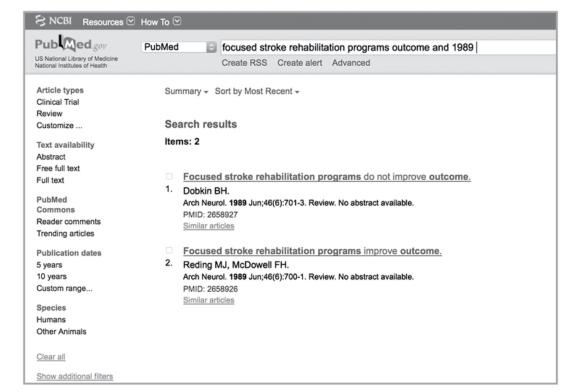Reading and interpreting research may be one of the most important tasks of an evidence-based practitioner. It is important to develop the skills necessary to identify the key findings and to disregard the superfluous information. Although critical appraisal is a topic left to a later chapter, next we present some practical guidelines for reading research evidence.
1-2. Read the Title and Abstract
The title of a research article can provide an important clue to the most important findings in the manuscript. But you should never read only the title and abstract. Some journal titles explicitly state the major finding of the paper. In a 1989 publication in Archives of Neurology, an article titled "Focused Stroke Rehabilitation Programs Improve Outcome" appears on pages 700-701 (Reding & McDowell, 1989) (figure 5.7). From the title alone, without reading the paper or the abstract, the reader learns that the investigators determined that a stroke rehabilitation program was effective in improving clinical outcomes. However, the very next article in the same volume of Archives of Neurology is titled "Focused Stroke Rehabilitation Programs Do Not Improve Outcome" (Dobkin, 1989) (figure 5.7). Which article is correct?

Two studies with directly contradictory titles that appeared consecutively in 1989 in Archives of Neurology.
Reprinted from PubMed.gov.
When the evidence-based practitioner relies on the title or abstract alone, he can make significant mistakes in the interpretation of research evidence. Also, examples such as the one just presented clearly show that research can be contradictory. The practitioner should read the title and abstract to determine whether the paper is relevant to the evidence-based question. If it is, he should proceed to a more careful reading and analysis to determine if the study methods and results support the findings stated in the abstract and title.
3. Read the Purpose, Construct, Theory, or Hypothesis Statement
After reading the title and abstract to determine the relevance of the study to the evidence-based question, the practitioner can skip to the final statement in the introduction that presents the study purpose, construct, theory, or hypothesis statement. This should provide the information needed to determine how the study should be designed to best answer the research question.
4. Read the Methods and Look for Flaws
The methods section is the most important part of a paper to read carefully and critically. It is from the methods section that an evidence-based practitioner can determine many of the potential biases and confounding factors associated with the study. This is also the section of the paper that determines the level or strength of evidence (chapter 8) provided by the research. As authors critically appraise their own research, they should carefully consider the study design, testing protocols, devices used, training and intervention protocols, statistical analyses, and study group allocations. If the authors are unclear in their presentation of any component of the methods, this should be a "red flag" to the reader and could potentially be a fatal flaw in the design.